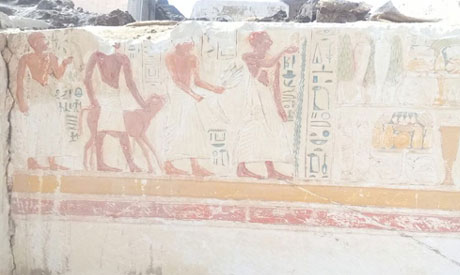
Professor of Egyptology at Cairo University Ola El-Aguizy has announced the discovery of an important tomb belonging to the great Ramessess II era General Iwrkhy in Saqqara, in a speech delivered to attendees of the Faculty of Archaeology Prom 2017.
The tomb was discovered in the New Kingdom necropolis south of the Causeway of King Unas in Saqqara, during the last excavation season in 2017/2018.
El-Aguizy, head of the mission that uncovered the tomb, said it most likely dates to the reigns of both Sethi I and Ramesses II. The site has yet to be fully excavated, but has already provided a wealth of material testifying to the high status of its owner and his family.
The tomb belongs to General and High Steward of the estates of Ramsses II in the Domain of Amun. His name is inscribed on the tomb along with that of his son Yuppa and grandson Hatiay -- the latter occupying a significant position in the inscriptions on the walls still in place.
Iwrkhy began his military career under King Sethi I and reached the highest positions in Egyptian court during the reign of Ramesses II. His tomb appears to mimic the style of contemporary tombs in the area, which include a forecourt, statue room with adjacent plastered vaulted storehouses, perystile court and western chapels (which have yet to be excavated), El-Aguizy said.
Archaeologists believe the general came to Egypt as a foreigner, one of many who settled here and managed to reach high positions in the court of the New Kingdom.
The scenes that remain on the walls of the statue room and on blocks found buried in the sand show a number of unusual scenes, many related to Iwrkhy's military career, and foreign relations with neighboring countries. These include an image of moored boats unloading Canaanite wine jars.
One block, most likely detached from the northern wall, shows an exceptional scene of an infantry unit and charioteers crossing a waterway with crocodiles. Preliminary studies of the scene determined that its fortified walls represent the eastern borders of Egypt.
The scene has only one parallel, depicted on the outer north wall of the hypostyle court of Karnak temple in Thebes. The scene shows Sethi I coming back from a victorious campaign against the Shasu Bedouins, entering Egypt by the same waterway with crocodiles.
The remains of such fortified walls were recently discovered by archaeologist Mohamed Abdel Maksoud and his team on the site known as Tell Heboua I and II on the Pelusian branch of the Nile in Eastern Qantara, North Sinai.
Discoveries in the Saqqara tomb also show signs of active daily life in this garrison, including wine cellars and livestock depicted on the walls.
The scenes of the high steward's tomb are quite exceptional, with artistic features characteristic of the time of Sethi I and Ramesses II. This indicates that the tomb was constructed over a number of phases.
The prominence of the names of Iwrkhy's family -- Yuppa and Hatiay -- suggests that this may have been a family tomb. Further excavation of the sanctuary and shaft are needed to confirm this.